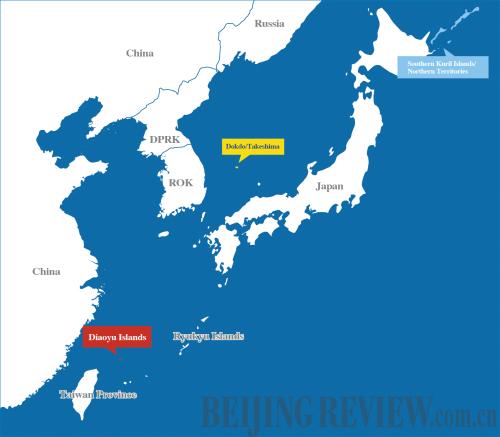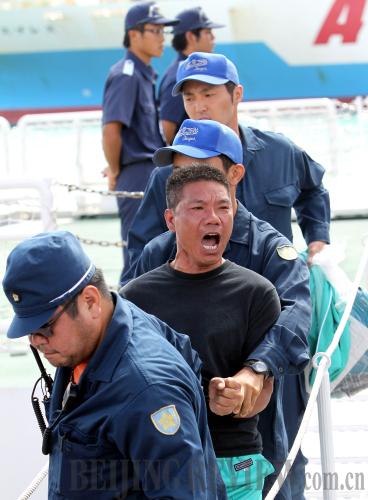Dangerous games in Northeast Asia
- By Ding Ying
 0 Comment(s)
0 Comment(s) Print
Print E-mail Beijing Review, August 27, 2012
E-mail Beijing Review, August 27, 2012

Japan has recently dug itself into the center of territorial rows with its neighbors in Northeast Asia. It is embroiled in island disputes with Russia and South Korea. In addition, the dispute over the Diaoyu Islands between China and Japan has emerged as a focal point of contention.
Chinese observers pointed to Japan's economic interests, U.S. influence and politicians' personal ambitions as the root of the renewed territorial disputes. Some warned that Japan could take a very tough stance on these issues, adding that its neighbors should be prepared to deal with a difficult diplomatic situation.
Causes of contention
Conflicting interests always form the core of international disputes. Territorial disputes are often seen as the concentration of complicated interests between different parties.
The most recent round of contention ramped up in July. Russian Prime Minister Dmitry Medvedev landed on the Southern Kuril Islands, known in Japan as Northern Territories, on July 3, drawing strong condemnation from Japan. South Korean President Lee Myung Bak's landing on Dokdo, which the Japanese call Takeshima, on August 10 led to Japan's threat to take the dispute to the International Court of Justice.
Seven Chinese activists soon thereafter were illegally detained by Japanese authorities for landing on the Diaoyu Islands on August 15, a day marking Japan's surrender in World War II. Then, a total of 150 Japanese lawmakers and members of right-wing groups went to the waters surrounding the Diaoyu Islands to mourn soldiers who died in World War II, and 10 of them set foot on the Diaoyu Islands on August 19. These successive events have rapidly heightened tensions in Northeast Asia.
Outsiders may ask why Japan has suddenly run into so many territorial disputes with its neighbors.
"While the disputes have different historical backgrounds, the Japanese Government's recent ocean exploration strategy is a prime reason for escalating tensions between Japan and its neighbors," said Zhao Xinli, a scholar on Japanese studies with the Communication University of China, to Beijing Review.
|
|
|
Japan's Okinawa prefectural police escort an activist on August 16, one day after a group of Chinese demonstrators were arrested for protesting on the Diaoyu Islands (CFP) |
He explained that Japan has sped up the pace of exploring ocean resources in recent years, especially after Yoshihiko Noda became prime minister last August. Noda recently stressed that Japan's top strategy for reviving the country should be ocean exploitation in a speech at Waseda University. He said Japan owns an exploitable ocean area 12 times that of its land territory. Noda pointed out that the ocean area under Japanese control is the sixth biggest in the world, while the area of deep sea at a depth of 5,000 meters under Japan's jurisdiction is the largest worldwide. Zhao concluded that given Japan's decision to focus on ocean resource exploitation, it will naturally maintain a tough stance on disputed islands.
Zhou Yongsheng, a professor with China Foreign Affairs University, believed that all the territorial disputes in Northeast Asia had connections with domestic situations in the related countries. For example, he said, Lee's stepping on Dokdo on August 10 happened because of domestic pressure prior to the upcoming presidential election. In July, Japan declared territorial claims on Dokdo in a defense whitepaper, triggering strong protest from South Korea. Previously, Lee had maintained a close relationship with Japan, said Zhou, which put the South Korean leader in an awkward position. Zhou pointed out that Lee tried to get political support and votes by taking a tough attitude to prove he is a patriotic president who will strongly protect territorial sovereignty.
On the Japanese side, Noda also has the task of winning support in the coming elections. As Zhou explained, since Noda and his Democratic Party of Japan are comparatively weak when dealing with domestic situations, especially in the country's economic recovery, he has to show strength in the diplomatic field to display his administration's achievement. "The inevitable outcome is Japan turning its neighbors into enemies," said Zhou.
Observers have said that U.S. influence is another important reason behind the current situation in Northeast Asia, as Tokyo is Washington's military ally in East Asia.
Zhou said as it shifts its focus to the Asia-Pacific region, the United States encouraged Japan to conduct a strategy of fierce confrontation with China, which indirectly led to the escalation of territorial disputes in the area. He explained that the U.S. Asia-Pacific policy also created similar effects in Southeast Asia, bringing out conflicts between China and the Philippines.
However, Zhou said, Washington does not want to see armed conflicts break out, forcing the United States to choose sides, which doesn't meet its interests.
Zhao agreed that the United States is an influential party behind these disputes. He stressed that Washington encouraged Japan to take a tough stance on the issues, and then used the ensuing squabbles in the region as an excuse to increase its presence in Asia. However, he believed Washington will not put Japan's state interests above its own, and will therefore not act as Japan's ally over these disputes. Zhao also noted that there's a strong sentiment in Japan calling on the Japanese Government to stop the current diplomatic strategy of fully relying on the United States.
Future of territorial feuds
Japan has recently decided to replace its ambassadors to China, South Korea and the United States. Observers believe this is a sign of the Noda administration's changing foreign policy. On August 22, Noda asserted that he had nothing to do with the new appointment, and the decision was made entirely by the Japanese Ministry of Foreign Affairs. The statement suggests Noda is losing control over some areas of the government, revealing an internal instability in the Noda administration.
Zhao pointed out that frequent replacements of prime ministers make it difficult for Japan's domestic and diplomatic policies to be coherent. The recent replacement of ambassadors is the corollary of Japan's unstable political situation. He said although the decision doesn't necessarily mean Japan will take a tougher stance on territorial disputes, it does reflect Noda's determination to adjust the country's diplomatic policy.
Current Japanese Ambassador to China Uichiro Niwa's successor, Shinichi Nishimiya, is very close with the United States, showing the Noda administration's consideration of the Untied States. "Whoever the next ambassador to China is will not completely change the current situation between China and Japan. There are difficulties, but there is also hope," Zhao said.
Zhou agreed that the transfer of diplomats is related to recent territorial disturbances. He said the Japanese Government is trying to achieve a diplomatic breakthrough by rotating personnel. Niwa publicly opposed Tokyo Governor Shintaro Ishihara's plan of "purchasing" the Diaoyu Islands in April because it would jeopardize China-Japan relations. Zhou said as Noda declared plans to "nationalize" the Diaoyu Islands, ambassadors like Niwa are now treated as obstacles to the "nationalization" plan.
Unlike Zhao, Zhou worried that the ambassador shift hints Japan's China policy will fully fall under the control of Japan's right-wing forces, hardening its stance on the Diaoyu Islands. He warned that Japan, while being practical in diplomatic relations, could adopt a fierce orientation through the media, public diplomacy, military exercises, the enlargement of weaponry and the expansion of its armed forces to fight for territory.
Nevertheless, Zhou suggested China should stay calm on the Diaoyu Islands issue. He said even though Japan controls the islands, no state-level leader has set foot on the islands. "We should be patient in dealing with Japan and the United States," he said, adding that a military solution is not a good option. But he also worried that both sides are very emotional about the issue now, which is detrimental to the China-Japan relationship and the whole Northeast Asian situation. Territorial games such as this are a constant danger—for the involved countries, and for the region as a whole.
History of the Diaoyu Islands
The Diaoyu Islands, located in the East China Sea between China and Japan, have belonged to China since ancient times. The islands are 120 nautical miles northeast of China's Taiwan Province, 200 nautical miles east of China's mainland and 200 nautical miles west of Japan's southernmost island Okinawa.
Geologically the islands are attached to Taiwan. The waters around the islands are 100 to 150 meters deep and there is a 2,000-meter-deep oceanic trench between the islands and Japan's Okinawa Islands. Fishermen from China's Taiwan, Fujian and other provinces conducted activities such as fishing and collecting herbs in the area for millennia.
The islands have appeared on China's maps since the Ming Dynasty (1368-1644). There are records noting the islands in a book published during the rule of Emperor Yongle (1403-24) in the Ming Dynasty, more than 400 years before Japan claimed discovery of the Diaoyu Islands in 1884. After the Ming Dynasty, the islands were recorded in many historical documents. On a map published by Japan between 1783 and 1785, marking the boundary of the Ryukyu Kingdom, the Diaoyu Islands were shown as belonging to China.
Japan never questioned China's sovereignty over the islands until the Sino-Japanese War of 1894-95. In April 1895, the Government of the Qing Dynasty (1644-1911) was forced to sign the Treaty of Shimonoseki, under which China ceded the whole island of Taiwan and its surrounding islands, including the Penghu Archipelago, to Japan. Only since then has Japan had its own name for the area where the Diaoyu Islands are located. Before that, Japanese maps marked the islands by their Chinese names.
Japan was occupied by the United States after it was defeated in World War II. In 1951, Japan and the United States illegally signed a treaty in San Francisco without the presence of China, which was one of the victor countries in World War II. While Article Two of the treaty said that Japan surrendered its claim over Taiwan and the Penghu Archipelago, Article Three assigned the Diaoyu Islands, which Japan had taken from China, to the Ryukyu zone, which was under U.S. control. Then Chinese Premier Zhou Enlai lodged a strong protest and said the Chinese Government would never recognize the San Francisco Treaty.
In a statement on territorial waters in 1958, the Chinese Government said that Japan should return all the territory of the People's Republic of China, including Taiwan and its surrounding islands, to China.







Go to Forum >>0 Comment(s)